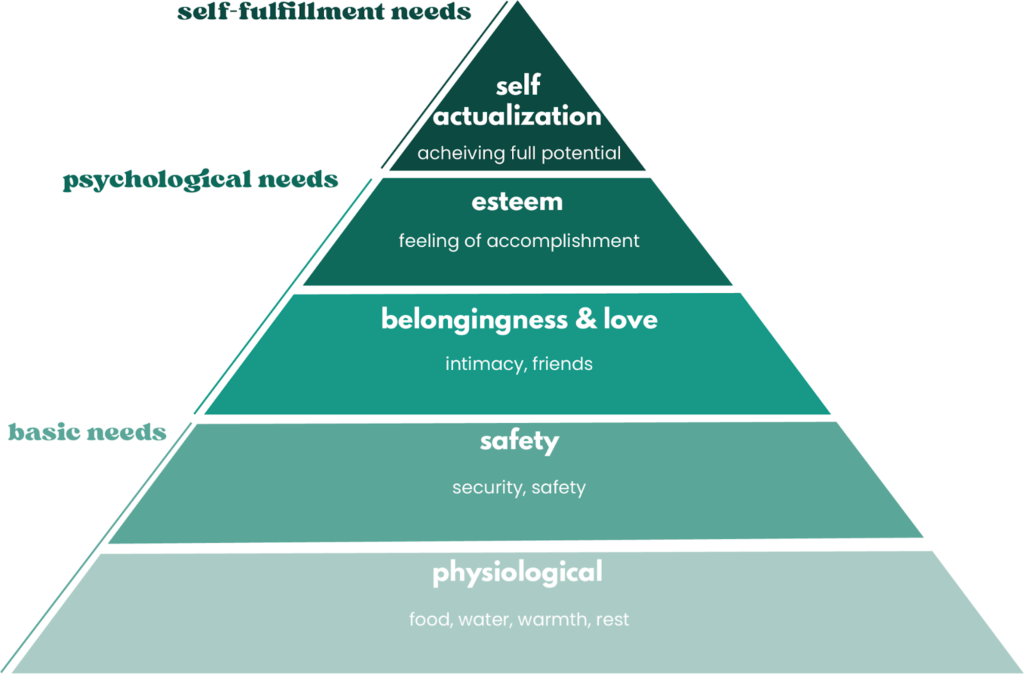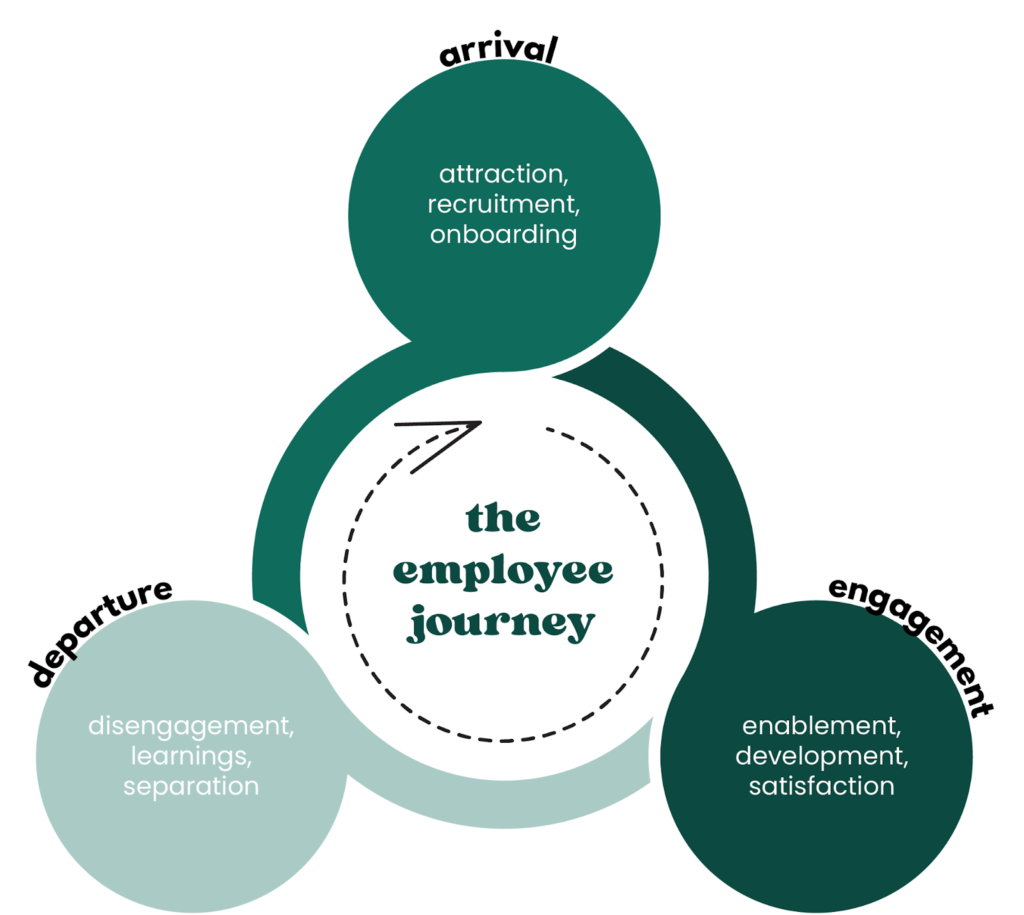Slap! 👋
Sometimes we need a big ol’ slap in the face to come to our senses. Vet med, you’re overdue for your annual wellness check. How are we all feeling?
This industry is beautiful, and it’s full of so many awesome, smart, kind humans. But it’s time we unify as an industry and take responsibility for our people’s collective experience, well-being, and success.
Friends – burnout, employee turnover, compassion fatigue, anxiety, and depression plague our profession. We hear you. We see you. We love you. Let’s come together, put together a treatment plan, and cure our cancered culture.
- #1 problem and priority in vet med is HR
- 33% weighted average employee turnover rate
- 95% of employees are somewhat emotionally exhausted at work
what is culture?
Culture can feel like an elusive, mystical word. But it is so, so much more than a buzzword.
Culture comes from the latin word cultus, which means “care.” And it’s defined as the values, language, and behavior of a group. Not so mystical after all!
Culture is a tangible, palpable thing that people create – together. And there are plenty of leaders in our industry who are working hard on getting it right.

"Culture, to me, means a healthy work environment. One that is true to its core values and is built on humility, communication, connectedness, and respect.
The best cultures are the ones where individuals can be their true selves and not be afraid to disagree and challenge each other. Where the best result comes from the collective, not just one individual.
When that happens and you connect a sense of purpose in the actual work with connection to the people and company, you know you are doing something right."

"My favorite part of leading other people is witnessing their professional and personal growth.
When a team member hits their stride, it gives them confidence and the momentum to shatter their limits.
Culture is so important. Without the correct values and norms in place, it is impossible to achieve psychological safety, trust, and integrity."

"Culture is extremely important to me because without strong culture, you can’t possibly achieve building a strong team!
Strong company culture enables a happier and more efficient work environment, empowers employees to feel pride in what they do, and allows team members to achieve greater goals both personally and professionally."

"I can honestly say that the greatest satisfaction that I have as a leader is helping others grown and learn.
Culture is the heartbeat of any great organization and therefore it needs to be nurtured and cared for.
A healthy culture is formed when leaders genuinely care about people and align their strategies around attracting and retaining people. I am maniacally focused on building and sustaining a great culture!"
In this extended article, we’ll explore what the best do right, and how to build cultures which allow people, and our businesses, to reach their full potential.
Heads up. This isn’t a quick read (~1 hour). This might even be worth printing out so you can highlight and take notes.
Healthy culture is the real deal, but it takes time, dedication, and intention to get there. We think this guide is an awesome resource, but you’ll need more.
If you’re signed up for hound and want a copy of the culture code or patients come second, we’ll happily buy a copy of the book for you. Just ask us at hey@hound.vet.
the 4 pillars of awesome culture
We need to get one thing straight – there is no master checklist. No two cultures will be identical. And they shouldn’t be!
Your culture is made up of the vibrant (hopefully diverse) group of people who commit their time, energy, creativity, and emotions to the company and each other. No two are the same!
So, there is no culture checklist. Womp, womp. We wish it were that easy, but there is no definitive list of action items needed to build (and maintain) your culture. The same goes for things like relationships – if you’ve got a step by step checklist of action items to build and maintain a happy relationship, it might be part of why you’re still single. Just kidding – kinda.
Luckily there are 4 reliable, guiding principles for building and maintaining healthy culture:
- Purpose
- Safety
- Vulnerability
- Growth
1. purpose
People want to believe in the work they do. They want to feel that their work serves a greater good, and that they personally get to make the world or the community they live in better in some way.
Pause for a sec. That’s powerful stuff.
You’ll find your purpose-aligned employees to be deeply invested and engaged in their work. They’ll stay employed with you longer and be far more productive. These are the superstars who go the extra mile for clients, provide excellent patient care, and go out of their way to make sure their colleagues and business are cared for and successful.
Companies with highly-engaged people outperform their peers by a whopping 147%. If you want a healthy culture that promotes this behavior (and the resulting client satisfaction and financial performance), you must start by aligning your practice and people to a shared purpose.

"All people desire to work for a purpose.
The team must feel a common sense of purpose with shared goals to be fully engaged.
Once we engage in that great purpose all the rest falls into place."

"If you're doing it right, culture should permeate the entire operation, from the work floor, to staff, to management and to the clients and their pets.
Good culture is reflected in your employees, as a side effect of them being happy, healthy and having their needs met.
Culture is everything!"
If your practice doesn’t already have a clearly-defined purpose, this will be an interesting exercise. Ask yourself and your people, “why do you do what you do?” The responses will be eye opening.
You can ask this question in a few different ways:
- During one-on-ones
- By conducting an all-staff survey
- Delegating it to your team leads and sending them and their teams to lunch
- Holding a staff meeting and asking people to write it down and drop it in a hat
How you collect responses is up to you, but you must aim to collect everyone’s responses and avoid selective hearing.
In one of our favorite healthcare culture books, patients come second, a successful hospital took this to another level.
They recorded these responses and made a montage. Each team member received a copy of this video. One immigrant team member shared the video with family members back home. She found purpose and pride in her work, and wanted to share those feelings with her family.
How awesome is that?! (I’m not crying, you’re crying).

"Just like those who work in human healthcare, those in veterinary medicine come with a heart for service.
To take care of those we serve, we need to take care of each other first.
Our organizations exist to enhance the lives of the people that work in them. If that’s our first priority, everything else will follow."
If you can’t tell, the impact of your culture flows well beyond the exam rooms and treatment tables of your practice! Let’s look at how to build this purpose.
how do you build purpose?
Building your purpose should not be done by management alone in a locked room. When something this impactful is developed and released into the world, the entire team should be involved.
From day-one receptionists to CEOs of the largest PE-backed consolidators, we are all people first.
We all have a voice. And every voice matters. If you’re still using authoritarian leadership at your practice, what does your employee satisfaction and turnover look like? Probably pretty bad.
To get started on building purpose, you will need to place your cornerstones:
- Mission: why we do what we do
- Vision: what we hope to achieve
- Values: what we care deeply about
- Culture Code: the rules we all play by (including your clients!)
With your team, maybe at an all-hands staff meeting, collectively establish the following:
mission
Answer the question, “why do we do what we do?”
Your mission should be meaningful, impactful, and clear. Concise is good, too.
At hound, our mission is: to inspire, empower, and support the people of pet care.
vision
Answer the question, “what do we hope to achieve?”
Your vision should be future-oriented and big picture.
At hound, our vision is: a pet care collective of happy, hardworking humans.
values
Answer the question, “what do we care deeply about?”
We can’t tell you what your values should be, but we suggest you focus on people before patients, and avoid leading with profits or market domination (though those things seem to follow great people and great culture).
At hound, we turned our values into an acronym to make it more memorable: hound c.a.r.e.s.
Community – we care for others and put people first.
Agility – we work together quickly.
Results – we deliver value and walk the walk.
Excellence – we give our best in everything we do.
Sympathy – we lead with compassion for others.
culture code
Your culture code reflects philosophies you expect your people, and maybe even business partners or clients, to live by. This should be stuff you’re proud to paint on the walls big and bold.
At hound, our team has created an awesome culture code. We call these our hound habits. We’re a software company, so yours might look a little different.
hound’s culture code (AKA hound habits)
Make it better: We are firm believers in continuous improvement and growth mindset. We are humble people who want to improve the world within and around us. Things will never be perfect, but you can always make it better.
Embrace the wind: Wind extinguishes a candle and energizes a fire. We take risks, embrace the uncertain, welcome challenge and failure, rebound, and grow. We encourage everyone to be a bonfire among candles.
Bake more cookies: We can either fight over the last cookie in the jar (competition), share the cookie (compromise), or bake more warm cookies so everyone can enjoy together (collaboration). Bake more cookies to build more win/win/win scenarios and reject zero-sum games.
Punt the skunks*: Skunks spray “negativity” onto others, and eventually, everyone starts stinking. Protect each other and our culture at all costs. Don’t be stanky. *No skunks were harmed in the making of this habit.
This exercise alone will illuminate your team, and might even help weed out some skunks. We’ll talk about how to deal with those people in the next section.
2. safety
People want to be safe and belong. Your people are everything, and your business really is nothing without them. Your people come first. Period. And you must establish safety as a constant in the core of your organization. You must protect your people at all costs.
PS, the customer is wrong a lot (looking at you, Karen.)
needs & the employee journey
In Maslow’s hierarchy of needs, safety is one of the basic needs of all human beings. We all share these fundamental needs, and we all know it’s hard to build anything without a solid foundation. Duh, Maslow.

For people to thrive, they must first feel safe, and they must remain safe throughout the entire human resource management lifecycle (distilled in the section below). It is our job as leaders to ensure our people are safe in the environments and cultures we build and foster.
- Safe from harm outside the business itself (no abusive clients, no cyber-bullying, etc.)
- Safe from harm inside the business itself (no bullying, no sexual harassment, no unsafe working conditions, etc.)
- Personal and familial security (liveable wages, good benefits, adequate time, etc.)

"Psychological safety is, without a doubt, the foundation for effective communication and team wellbeing.
When veterinary team members feel comfortable to speak their mind, share ideas, disclose mistakes, and hold each other accountable, there are no limits to the obstacles that the team can overcome."

"Quite simply, psychological safety is the fertile earth in which innovative, resilient, thriving teams grow.
Without it, veterinary teams can get things done but their capacity is stunted.
With it, veterinary teams unleash the magic found at the furthest reaches of their incredible potential."

"I can tell you that people are basically all the same. They want to love and be loved, be safe, have opportunities, and see their children thrive and not just survive.
You can’t feel happy and be healthy if you have fear, anxiety and stress. Safe employees are physically and emotionally around for the long run."
The tricky thing about culture? It’s a continuum. Culture, and all its parts, requires constant prioritization and attention to detail. It’s important to view this holistically, and understand that you must ensure safety throughout the entire employee journey of your people, over and over again. It’s no cake walk, but it’s worth every ounce of effort.
Interested in learning more about psychological safety? Check out our blog: Why Psychological Safety Should Be a Core Focus in Your Veterinary Practice
To prevent turning this big ol’ article (BCS 9/9) into a chapter book, we’ve distilled the HRM lifecycle, or employee journey, into three high-level parts: arrival, engagement, and departure.

A. arrival
the moment of arrival
Whoa. It even sounds cool, because it is, and you should take great care in focusing on this remarkable moment. Moments of arrival should be magical.
Our brains are hardwired to quickly determine if we are safe or not when we enter a new group or space – it’s called situational awareness. A new job is a significant moment of change in a person’s life, and you have an opportunity to create a lasting positive impact in your people’s journeys by ensuring safety at their moments of arrival.
In another one of our favorite books, the culture code, we learn how one company significantly improved employee satisfaction and retention.
What was one of their favorite tricks? They made sure their new hires received a personalized welcome gift on day one. Seriously, how easy is that? If you’re not already, start doing that today!
Here are just a few easy ideas to implement to make sure your new hires have memorable moments of arrival:
- A signed welcome card from the entire rest of the team
- A giant welcome poster made by the rest of the team
- A human tunnel when the new team member walks in
- A welcome lunch party
- A stethoscope and engraved ID tag
- A branded tote full of goodies for them and their pets
- A special pen and notepad
- An engraved water canteen
- A gift card for the new team member and a significant other to enjoy a celebratory meal
Do that kind of stuff. Seriously. Go as big and bold as you can!
If you focus on the moment of arrival, your new employees will find instant belonging, feel safe, and forge a greater bond with you and your company.
Want to get a deep-dive on how to make your employee's moment of arrival incredible? Check out our blog: How to Make Your Vet Staff's First Day Memorable
diversity, equity, and inclusion
The people of veterinary medicine are some of the most hilarious, resilient, rowdy (oh yeah, we know), driven, compassionate, vivid, intimate, and vibrant people. It is full of kind, smart humans. It is women-led. It is millennial-dominated. It is growing more diverse. And it is evolving into an experience-driven, tech-enabled, people-first industry. Yes, please. About dang time!

"The culture of a practice or a profession has a direct impact on an individual’s ability to be their authentic selves.
I have experienced this firsthand as a transgender veterinarian who went through gender transition from female to male during my career.
Diversity is important in vet med because when everyone is represented, we can create a nurturing and supportive culture.
Without diversity, supportive culture is not sustainable and vise versa. Supportive culture is the way of the future, with out it, our society is not sustainable."

"Diversity, as well as equity and inclusion, are critical to good workplace culture.
Having differing viewpoints and viewpoints that represent the communities we serve as veterinary professionals improves wellbeing for our clients, our patients, and our colleagues.
Making sure that underrepresented and excluded groups, like BIPOC (Black, Indigenous, People of Color), can access and are included in our profession will strengthen our profession and expand our collective reach."
Today’s workplace doesn’t look like yesterday’s, and tomorrow’s will probably look different, too. We are on the cusp of profound generational and industry shifts. But one thing is certain. To ensure healthy culture and to be a leading employer in today’s world, you must prioritize diversity, equity, and inclusion (DEI).
Diversity is variety in any given group. Variety in race, age, nationality, ethnicity, culture, gender identity, physical and mental ability, education, work experience, politics, religion, citizenship, marital status, socioeconomics, and more!
Equity is ensuring all people can reach their full potential. This is distinct from equality which is giving everyone identical resources. Equity goes a step further and balances the imbalance of opportunities and outcomes of all people.
Inclusion is a sense of belonging and worth felt by all team members. If you’re doing inclusion right, marginalized groups won’t feel segregated, excluded, or tokenized. You will have a true “melting pot” of respectful and cohesive team members.

"DEI is really just humanity.
We all know how important humanity is to us, and how important it is to include everyone, to give equal opportunity, and provide equity for everyone.
When done right, it's the perfect recipe for serving the community and serving the world."
There’s truly no good reason not to support DEI initiatives. We believe people are inherently good, and instinctually compassionate towards others. But if you need some other external motivation to implement DEI initiatives, here are some powerful stats.
- 57% of employees think companies should be more diverse
- 67% of job seekers value a diverse workforce when considering jobs
- Gender-diverse leadership is 25% more likely to outperform their peers on profitability
- Ethnically-diverse leadership is 36% more likely to outperform profitability benchmarks

"Welcoming people from diverse backgrounds into your teams is extremely beneficial when establishing a strong culture.
Diversity improves access to animal healthcare and education to many underserved communities.
Creating a culture of inclusion can result in increased employee retention, greater commitment and input from your employees, which can lead to markedly improved business outcomes.
The profession needs to start connecting with people and organizations that are "disrupting" the norm and creating positive change in our industry."
So, now you want to implement DEI initiatives. Where do you start?
- Assemble a diverse team to own and collaborate on these initiatives (e.g. a practice manager, DVM, tech, and receptionist)
- Analyze your current standing and define what can be improved (survey your team, audit yourself)
- Commit to improvements, and allocate time and money to get there
- Ensure your hiring, training, and compensation practices are fair and intentional
- Hire a DEI consultant to support you!
You will never be “done” with your DEI initiatives. Once you commit to DEI in your practice, you will need to continually diagnose and nurture. If you do it right, you will also continually experience healthier culture and achieve better results as a team.
Want more tips on how to better infuse DEI into your practice? Check out our blog: How to Celebrate Diversity, Equity & Inclusion in Vet Med

"I am a firm believer that people are always your most valuable resource.
When diversity is combined with an inclusive culture, each individual feels free to be their authentic self in the workplace.
This leads to a safe and trusting environment where all can flourish and do their best work."
B. engagement
This is where the magic happens.
Successfully creating a culture centered on employee engagement can lead to up to 18% higher revenue, per employee. Remember how we told you companies with engaged employees outperform their peers by nearly 150%? That’s fine and dandy, but 67% of U.S. employees are not engaged at work.
There are many reasons people become disengaged in their work. Here’s a painful list of things you want to avoid in your practice:
- lack of sense of purpose
- poor compensation (wages + benefits)
- lack of recognition
- limited growth opportunities
- weak leadership
- lack of feedback
- weak communication
- lack of resources
- personal misalignment with company’s goals
- company’s lack of interest in employee well-being
Who wants to work at a place like that? If you’re starting to catch on, you’d probably guess unhappy, unhealthy, disengaged employees begin to hurt the company in several ways:
- absenteeism and employee turnover
- decreased quality of patient care
- poor client reviews
- disengagement of coworkers
- culture erosion
- decreased productivity and financial performance
Yikes. Lucky for you, we’re well on our way to helping you adopt preventive care of your company’s culture.
Let’s use Herzberg’s two-factor principle to set some context real quick.
- The opposite of satisfaction is no satisfaction (importantly, it is not dissatisfaction).
- The opposite of dissatisfaction is no dissatisfaction (importantly, it is not satisfaction).
You must focus on both maximizing satisfaction and minimizing dissatisfaction to achieve the greatest employee engagement.
.png)
Hygiene factors drive dissatisfaction. These are the things a company should focus on at the very least to get employees in the door and prevent them from leaving quickly. Failing here won’t allow you to drive employee engagement. Consider this your defense, and the bare minimum your people will expect of you.
Motivator factors drive satisfaction. These are the things a company should focus on to inspire, empower, and support their people – and in turn achieve organizational excellence. Consider this your offense, and the opportunity to take your people, and company, to new places and greater heights.
Now, let’s put it into practice.
compensate your people better
Adequate pay and benefits is top of mind for your employees, and it is the #1 way to avoid employee dissatisfaction. This falls in Maslow’s category of basic needs. Interestingly, compensation is also one of Herzberg’s hygiene factors, meaning it isn’t a primary driver of employee satisfaction. Yep, you read that right.
Just because you compensate your people well doesn’t guarantee they’ll be satisfied or fully-engaged in their work.
It means they won’t be dissatisfied (or gripe about their pay or lack of benefits in the break room). You absolutely must compensate your people well, but you’re not off the hook that easily!
Compensation impacts both attraction and attrition. This isn’t rocket science. If a job doesn’t compensate well, you likely wouldn’t apply to the job in the first place. If you find yourself financially distressed, feeling underpaid and undervalued, or struggling to afford needed healthcare, you likely won’t work very hard or stick around at your current place for long.
Cutting corners on compensation and employee engagement is a huge mistake.
- A disengaged employee costs an organization approximately $3,400 for every $10,000 in annual salary.
- Disengaged employees cost the American economy up to $350 billion per year due to lost productivity.
That can really sting! Trust us (and all the super-smart economists), it hurts you much more to have a disengaged or lost employee than it does to compensate well.

"People deserve fair compensation and if you fail to offer it, you will not attract top talent.
AND compensation alone will not build loyalty, wellbeing or happy teams.
Leadership needs to provide opportunities for autonomy, growth/mastery, and pride in the work and the organization itself."
Not sure what to pay your people? A good rule of thumb, don’t pay veterinary hospital personnel less than fast food workers. C’mon! Here’s what leading veterinary industry employers are paying their veterinary teams:
- Receptionists and Assistants: $15/hr +
- Technicians: $20/hr +
- Practice Managers: $70k/yr +
- DVMs: $100k/yr +
Not sure what types of benefits to offer? Here’s what the best are offering:
- Healthcare, Vision, Dental
- 401K
- 529 Plans
- Pet Insurance
- Sign-on bonuses (for any team member)
- Generous PTO
- CE Reimbursement
- Tuition Reimbursement
- Profit Sharing
- Parental Leave
It’s much cheaper to compensate your employees well than it is to hang onto disengaged employees, or to constantly replace and train new hires. On average, it costs a company 6 to 9 months of a fully-trained employee’s salary to replace them. Holy smokes, batman!

"Members of the veterinary industry spend every day putting their patients first; and it is time that they are shown the same level of support.
At CareVet this means supporting Team Member's financial health, by paying a living wage of at least $15/hr, physical and mental health, by investing in best-in-class benefits and resources, and professional health, by providing customized paths and education for career advancement.
Healthy team members drive healthy culture and healthy culture creates space for healthy pets."

"Pay and culture are hard in the veterinary industry. For many, pay equals respect and value.
When we start paying ALL staff appropriately there will undoubtedly be a culture shift.
Leadership fostering a psychologically safe work environment comes from leaders who are willing to walk the walk and talk the talk."
You get what you pay for, so pay your people better. We couldn’t be more direct (deposit) 🥁 😉
improve your people’s working conditions
One of the core causes of burnout is overwork. We know that working conditions are a hygiene factor (again, the bare minimum you should be focusing on for your people). You can’t skip this stuff.

"Having a culture of wellbeing for your veterinary hospital should be non-negotiable from 2021 onward.
No one comes into vet med to be stressed out, burnt out, and overwhelmed.
Leaders must understand the value of investing heavily into the hospital’s culture and realize that it will also be good for business!"
leading and lagging indicators:
- Consider a leading indicator a cause.
- Consider a lagging indicator a sign or symptom.
Strong employee engagement is a leading indicator for greater client satisfaction and better patient outcomes.
Strong employee engagement, greater client satisfaction, and better patient outcomes are leading indicators for stronger financial performance.
Somehow, lots of companies get this backwards.
Thinking you must first achieve strong business outcomes in order to invest in your people is a trap! Companies who fall into this trap are wrong and feel the pain.
Waiting to invest, or much worse – never investing, in culture, technology, and community is a big mistake. Invest early, and if you’re late to the game, start now. Your people and your business will grow.
i. Regularly assess and upgrade your practice facilities & technology
By keeping your practice up to date, you equip your people with tools and resources they need to complete their work more efficiently and effectively. This will save hours of headaches, and bring you greater client satisfaction, better patient outcomes, stronger employee engagement, and stronger business performance.
Are you still using paper charts or old software? Still don’t offer pet owners real-time online appointment booking? Don’t have a convenient client communication platform? Still not offering online pharmacy or refill delivery? Struggling to manage your inventory? Lost on how to effectively market? No idea what any of your data looks like? It’s okay, you’re not alone.
Modern software fixes all of that!
If you’re hesitant, don’t know where to start, or maybe even scared of change, e-mail us and we’ll help you explore your options free of charge (hey@hound.vet). We personally know many of the innovative companies working to make vet med better, and we’re happy to introduce you.
A note to practice managers:
Please take this advice to heart. ❤️
Here comes a little bit of tough love.
You’re expected to manage clinical operations, customer service, inventory, HR, marketing, finance, analytics, and more. That’s a lot of really hard work. Honestly, do you have all the education and tools needed to properly manage all of it?
Without adopting modern solutions and support – brace yourself for this – you will never come close to beating the status quo, and you will never achieve greatness in your role (how could anyone?).
It’s easy to drown as a practice manager. And if practices continue to refuse modern solutions, their teams will continue to struggle, the HR crisis will continue to worsen, and managers will be stuck putting out fires and doing everything they can just to keep the ship afloat each day. I know that’s not the future any of us dream of for veterinary medicine.But there’s good news. Lots of it!
Practice managers have solutions available to them for all of this, and veterinary companies (software, pharmaceuticals, equipment, coaching, etc.) are here to help. They can be great assets and allies to you. They can make your job much easier. They can make your practice perform better. They can reduce everyone’s stress. And usually what they’ve got is well worth your time and money.
Two things to easily change immediately:
- Train your reception teams not to gatekeep management. Stop making receptionists tell sources of support that you’re, “in a meeting.” No, you’re not. We know all your little tricks! Excuse our four-letter word, but that one’s lazy.
- Stop justifying the status quo by saying “this is how we’ve always done it,” or, “the owner is old school.” The times they are a-changin’! Clients’ expectations have changed. Employees’ expectations have changed. You and your practice must change, too, whether Dr. Old School wants to or not. Seek growth opportunities as frequently as possible. It’s our duty as leaders to continuously improve our profession and encourage others to do the same.
P.S. I say all of this with a whole lot of love and empathy. I’ve been in your shoes and know the struggle. It is freakin’ REAL. But there are plenty of technologies and smart people who exist to help make it easier. Keep your minds open and work to always make it better.
❤️ Andrew, a former Practice Manager
Want to learn more about adopting new technology? Check out our blog: How to Seek & Adopt Modern Veterinary Technology
ii. Enforce lunches and closing hours
Your people need to rest and recharge their batteries. Remember that whole Kreb’s Cycle thing? Without lunch breaks, your employees won’t be able to transfer high energy electrons to the electron transport chain! (lol, thanks Google).
Okay, so we don’t remember the Kreb’s Cycle. But we do know you must make sure your people get to take a lunch break or you’ll burn them out. Duh. This is the easy stuff. But we’re not scoring 100% here yet.
Also, you and your people have lives outside of work and personal boundaries. Make sure people go home on time to their spouses, fur babies, and even video games. Overwork and overtime eats your people alive – it also puts financial strain on your business.
Depending on the size and type of your practice, try some of these suggestions to help make lunches and clocking out on time possible:
- lock the doors, put up a sign, and switch over the phones during lunch hours
- schedule and enforce team members’ lunches
- stagger DVM schedules and lunches
- stagger support staff schedules and lunches
- allow no sick appointments to be scheduled 30 minutes before lunch
- turn away walk-ins if you have no capacity (overextending is bad for your people and bad for quality of patient care)
- allow no sick appointments to be scheduled 60 minutes before closing
- schedule your teams to account for at least 30 minutes of closing duties
- adopt every form of modern veterinary technology available (worth every second to set up and every penny to purchase)
If you regularly overwork your employees, they’ll become emotionally, mentally, and physically exhausted. They won’t feel safe. And soon enough – say it with us – they won’t work for you anymore.
iii. Enforce and respect employee time off
Fun fact: 37 of the world’s wealthiest nations are members of the Organization for Economic Cooperation and Development. The US is a member, but we are in very last place when scored on employee time off. Woohoo! ‘Merica.
Our people need time to attend to their personal lives. They’ll need time to go to therapy, to watch their kid’s recital, enjoy a hike with their dogs, or go on a hot date. And they shouldn’t need to explain their time off requests. We also shouldn’t expect them to be available on their scheduled days off.
More than just offering paid time off (PTO), we suggest you encourage and enforce the use of PTO. It’s also a good idea to leave your people alone while using PTO and while they’re on their regularly scheduled days off.
Employees encouraged to use their PTO are much happier with their jobs than those who are discouraged to use it. This all applies to the occasional day off, as well as the week-long vacations we all need to relax and recharge. Employee performance can increase by 80% after taking vacation, so encourage it!
You have to do this stuff, but time off and vacations must be paired with a healthy workplace to keep burnout at bay and engagement in the green. David Ballard, PsyD, MBA of The American Psychological Association shares our stance and sums this up well.
“Employers shouldn’t rely on the occasional vacation to offset a stressful work environment. Unless they address the organizational factors causing stress and promote ongoing stress management efforts, the benefits of time off can be fleeting. When stress levels spike again shortly after employees return to work, that’s bad for workers and for business. Employers can do better.”
We agree with David. Create healthy work environments, and give people time to be people. Employers can do better. We all can!
iv. Don’t cater to all pet owners
Clients don’t play by special rules and aren’t exempt from your culture code! It’s very important to recognize that the customer is not always right, and they absolutely do not come before your people. Take care of your people, and they will take care of your clients.
Be very cautious not to over-cater to pet owners, or over-extend your people.
- If you don’t have enough veterinarians or support staff to cover shifts for your current open hours, hire immediately or decrease your open hours.
- If your clinic is slammed, people aren’t taking lunches, and your team is exhausted, turn away all non-emergency walk ins.
- If you’re not equipped with staff or equipment to handle additional hospitalized patients, do not admit them.
- If your surgery department is fully booked and already doesn’t have time for potty breaks, don’t squeeze in that extra procedure.
- If that one client is being a terror again, protect your team and fire the jerk!
You get it.
When it comes to setting boundaries around client behavior, there’s not much to think about. No racism, sexism, bigotry, harassment, or abuse of any kind should be tolerated.
Clients are banging down the doors at vet clinics! Pick the good ones and don’t let the crappy ones waste your people’s time or energy.
Plus, if you allow abusive clients to stick around, your team won’t feel safe or trust you to protect them. Oh, and it’s okay to respond to negative reviews publicly to make things right if you messed up. You should also respectfully defend your practice and your people if the customer’s out of line or not right in their online review.
All the small things matter so much.
Every practice seems to be short on staff, and it’s very much an employee’s market today. Your working conditions can either give you a huge leg up with employees and job seekers, or it can be a big reason why you’re always short staffed and can’t find people to hire.
encourage your people
This one’s on our favorites list. You have all the room in the world here to be innovative, thoughtful, and incredibly kind. Plus, Maslow would be proud of you for addressing your people’s psychological needs.

"An inspiring work culture is a business game-changer.
Giving your employees an environment where they can grow, engage, and thrive will take a practice from ordinary to extraordinary!"
i. recognition and reward
Recognition and reward is a seriously powerful thing. Double high five from Herzberg for getting this motivator factor right.
Workplace recognition motivates people, provides a sense of accomplishment, and makes employees feel valued for their work. Recognition not only boosts individual employee engagement, but it also has been found to increase productivity and loyalty to the company, leading to higher retention.

"We come to work when the sun rises and leave when the sun sets.
I feel employers are obligated to make sure we are all doing well mentally.
Acknowledgment of work being done well is a great ego boost, and our productivity shows whether we are happy in one place or not."
Recognition and reward should include the entire team, meaning it shouldn’t only come from management. In fact, recognition and reward initiatives amongst coworkers avoids perceived favoritism and is more powerful than coming from leadership alone. Here are a few ideas to implement:
- make it a habit to say thank you to each other, publicly, all the time
- team huddle at the start of the day, thank everyone for their commitment to the day ahead
- high five/fist bump when you complete rooms or tasks
- someone else got that IVC placed in a kitten you couldn’t? Dance party!
- write shoutouts for each other for awesome work on a public recognition board (whiteboard in the treatment area, corkboard in the lunchroom, etc.)
- read shoutouts at staff meetings
- DVMs surprise their support staff with coffee or lunch
- employee of the month/MVP gifts
- print and display positive client reviews
- positive client review incentives for employees
- team huddle at the end of the day, highlighting moments of greatness
- catered lunch, a potluck, a day off, or some gift to mark work anniversaries and other life accomplishments
Heck yeah!
ii. emotional contagion
Reading that list above probably made you feel good. Now imagine being around those positive interactions throughout your day. You’d probably pick up on some of that positivity, even on your worst day. This concept is called emotional contagion.
Let us illustrate how powerful this is.
Good apple, bad apple
The setting is a conference room. A group of strangers (the control group) have signed up to be paid for a day-long product and strategy feedback session.
Test 1: A bad apple (AKA negative influencer) is placed in the group. This bad apple immediately starts complaining, lays his head on the desk, and is reluctant to focus on the tasks at hand.
Test 1 result: Members of the control group mimic the bad apple’s behavior and deliver suboptimal work.
Test 2: A good apple (AKA positive influencer) is placed in the group. This good apple immediately starts kindly greeting the others, sits attentively in her chair, and happily collaborates with others on the tasks at hand.
Test 2 result: The control group mimics the good apple’s behavior and delivers excellent work.
Test 3: The bad apple (AKA negative influencer) and the good apple (AKA positive influencer) are both placed in the group.
Test 3 result: The control group mimics the good apple’s behavior, neutralizes the bad apple, and delivers excellent work.
Now that you see the power of emotional contagion, we can not stress this enough:
Do not romanticize or humorize negativity in your practice.
This is a big one. Complaining and dark humor is very prominent in our profession. We admit, sometimes it’s absolutely hilarious, but at its core and with enough repetition, the negativity consumes us and transforms our perception in a very harmful way.
Remember how good it felt to read the recognition and reward bullets? Now read this:
- team members proudly wearing burnout on their sleeves as a badge of honor
- team members competing to appear the most stressed
- team members posturing over one another, seeking to be the smartest or most in control
- practice leadership publicly complaining about work
- finding something negative to say about every client that comes in
- practice leadership publicly reprimanding employees
- vets complaining publicly about their clients or caseload
- team members saying “I’m done with this place” in the break room
That list didn’t feel so good, did it? It felt bad writing it.

"If a workplace operates from a place of honesty, integrity, compassion, and empathy... and those values guide behaviors that are likely to spread to others, we can see how that could positively impact a team.
However the opposite is also true! For better or worse, we have an impact on the mood and behavior of others (and the reverse is true too, other people can also influence our mood and behaviors!).
Humans are social creatures. Knowing this phenomenon is important when creating and maintaining a great (or not so great!) culture."
Positive language and behavior (e.g. recognition and reward) can greatly impact the emotions of the group. But so can negative language and behavior.
You can’t ban negativity, and we’re not saying you should try to. The toxic language and behaviors above are symptoms of a cancered culture. You must take a proactive, preventive approach to combat this. You must ensure your people are engaged.
If you’re experiencing any of these toxic traits in your practice, you’ve got some introspection and culture cleanup to do! It is our responsibility as people leaders to build and protect the sandcastle (more on that hound metaphor in the departure section below!)
iii. have fun!
.jpeg)
"Fun in the workplace - YES!
You can do it, especially in veterinary medicine. Don't take yourself too seriously.
Life is too short, my friends. You have to have fun in the workplace. Enjoy life!"

"We provide employee engagement resources for our family of hospitals to build their own fun programs, but it’s completely optional and customizable.
We also provide additional resources that go hand in hand with building great teams, while infusing fun into everything we do! This includes employee recognition, mentorship programs and encouraging our teams to have fun in and outside of work.
My favorite core value is “Be Nice, Be Bold, Have Fun”! That’s something that everyone can rally around."
The average person will spend – wait for it – 90,000 hours at work in their lifetime. We spend ⅓ of our adult lives in the workplace. That’s a whole lot of time to be in a bad mood or stressed out. Make sure your people are having fun!
Fun in the workplace strengthens interpersonal bonds, reduces stress, improves job satisfaction, reduces employee turnover, improves client experience, and enhances productivity. It’s no surprise happy, engaged teams outperform grouchy, disengaged teams.
Before your people are assistants, receptionists, technicians, veterinarians, practice managers, regional directors, etc. – they’re people. Vibrant, diverse, beautiful people.
Take every opportunity you get to connect personally, and make your people smile and laugh often. Here are some ideas on having fun, (yes, some are super corny):
- Support their interests (volunteer together, video game nights, book clubs, etc.)
- Team building games at every staff meeting
- Let your team pick the catered lunch (pizza’s cool and all, but mix it up a bit)
- Keep games at the practice for lunch breaks and slow periods
- Cook-offs and bake-offs
- Schedule hikes, paddle boarding, tacos and margaritas with your teammates
- Your own version of elf on the shelf
- Safe, friendly pranks
- Talent shows
- TikTok Dances (we can’t believe this made the list…)
It won’t always be sunshine and rainbows. There will be days and months (and apparently year-long pandemics) of challenging times. If your employees are engaged, you’re in great shape to brave the inevitable storms of running a business. If they’re not, fix it quickly or make sure your job postings are up to date.
C. departure
We know one thing for certain. Your employees won’t be with you forever – even the most engaged ones. We know, it sucks, but it’s the reality we all face. Offboarding is a natural part of the employee journey.
In the best case, you inspire, empower, and support your people. And they do the same for their coworkers. But, they still eventually leave to start a family, launch their own business, live somewhere new, retire, or focus on themselves. We should celebrate those awesome things!
When you celebrate these life events and share happiness for your people, even when they leave you, you strengthen your people’s confidence in your genuine care for them as people. They’ll feel safe.
In the worst case scenario, you’ll lose an awesome team member because your culture wasn’t cutting it or you didn’t meet their needs. Ouch, that was your fault. Learn from it!
Firing people can feel even tougher than people leaving you. But you have to fire people for poor performance or lack of culture fit.
If you make the commitment to fostering healthy culture in your practice, you must always protect the sandcastle.
Protect the sandcastle? Yeah, every day. Like your life depends on it.
Imagine you’re at the beach. You purchased and carried tools like shovels and buckets to a nice spot. You brought a group of people together you really enjoy, and you worked hard together for hours to build the coolest sandcastle you could have ever dreamed of.
And then someone starts smashing your sandcastle.
Would you stand by and let them do it? Even if they helped build the sandcastle? No way, Jose!
We all have met sandcastle smashers in practices. Those people have got to go, ASAP. Even if they’re top revenue drivers (known as toxic performers). You MUST solve the behavior or fire them as quickly as possible. Otherwise, they will wreak havoc on your practice and your culture. And if so, you probably guessed it – your people won’t feel safe.
Here are a few rules we suggest you follow when it comes to offboarding employees.
Hire fast, fire fast
Obviously make sure people are a good fit, don’t hire willy nilly. But when you find great people, hire them quickly or someone else will.
On the other hand, even your best people can turn sour. It’s rough when they can’t or won’t resolve toxic behavior or poor performance with your support. When this happens, fire them quickly or brace yourself for systemic toxicosis.
Learn what they would change
When people leave, be prepared to be vulnerable (more on that in the next section). Conduct exit interviews and ask them what they would change about the company. Some of this might sting, and it might even be that you’re kind of a lame boss.
At least one person who reads this will fall into the bad boss bucket. Did that make you feel uncomfortable? If yes, that means you might be a bad boss. But all of us can improve! Listen intently, because in order to solve, you must first understand the problem.
Never publicly humiliate
If your employees see their employer publicly humiliate or speak poorly about people who leave the company, they’ll know you’d do the same to them when it’s their turn. They’ll feel disposable, replaceable, and see through any attempt you make at valuing them personally.
This is bad news bears. It’s mean. Don’t do it.
Celebrate journeys
The companies with the best cultures manage off-boarding with grace. Employees who know their employer will support them, well beyond their time with the employer, feel safe.
This can lead to radical transparency from your team members about their future plans, and allows you to proactively hire, onboard, and train. Your employees might even bring their own replacements if they know you’ll treat their friends well.
3. vulnerability
Healthy teams trust each other, learn together, and build up one another’s confidence. These things allow us to problem-solve, connect with others, and unleash innovation. Vulnerability is the building block for all of this.

"Veterinary medicine is a team effort. Each team member plays a vital role in the experience and care a pet gets when they come into the doors.
In order to provide the highest quality care, we all must work together and synergistically.
Good culture is crucial in this field as this can help uplift everyone’s time at work in a sometimes difficult and exhausting profession."

"Leaders who show vulnerability allow others to do the same. It creates an environment of trust as being vulnerable in the presence of others takes courage and one must put their trust in others.
Leaders can be more vulnerable by being honest and transparent.
We are all human and being able to be vulnerable promotes relationship building for a stronger team."
a. status management
Let’s kick this section off with a story about a nasty thing called status management.
The setting is a large college classroom. You have teams of MBA students, CEOs, lawyers, and kindergarteners.
The task is this: using raw pasta noodles and marshmallows, build the tallest structure you can in a few minutes.
The booger-eating kindergarteners get their butts handed to them every time, right? Wrong.
Nearly every time the kindergarteners win. And on average, they build a structure that is twice as tall as the adult teams.
While the kindergarteners used their time to quickly problem solve, try, fail, and iterate, the other teams were stuck on status management.
Who’s in charge here? Where do I fit into the equation? Should I say something? What if I’m wrong? What will others think?
That’s status management. It’s incredibly limiting, and it’s rooted in a lack of vulnerability.
We unfortunately see status management commonly on veterinary teams.
- It’s the power struggle between practice managers and associate DVMs.
- It’s the power distancing between veterinarians and their support staff.
- It’s the technicians posturing over receptionists.
- It’s the assistants made to feel less than the rest.
- It’s the old guard making new hires feel like they have to earn their stripes.
It’s all toxic behavior, and it stems from insecurity. The solution is vulnerability. We define vulnerability as a skill. It’s an ability to be humble, honest, imperfect, wrong, and the student.
- It’s knowing you know so little.
- It’s being comfortable making mistakes.
- It’s accepting that others will have strengths and weaknesses which you don’t.
- It’s acknowledging you can’t be everything for everyone.
- It’s agreeing to keeping an open mind.
- It’s appreciating thoughts and opinions other than yours.
- It’s welcoming unrestrained creativity of yourself and others.
- It’s craving knowledge and life experience in pursuit of continuous improvement.
Vulnerability is humility’s twin, and it’s awesome. Once we’ve committed to being vulnerable, we can communicate and collaborate much more effectively.
Vulnerability looks like:
- Practice managers apologetic after learning that their behavior upsets the team
- DVMs humbly asking technicians what they’ve seen work well in unique cases
- Technicians thankful for receptionists asking if the medication being dispensed is the wrong one
- Practice owners appreciating technicians pointing out flaws in their treatment plans
- Team members eager to learn and teach one another without posturing
- Practice managers trusted by their people to provide meaningful, clear feedback and dispute resolution
- Practice owners leaning on practice managers to make more decisions and take more control of the business
Vulnerability enables all of these wonderful things, and more. By focusing on team vulnerability, you wash away challenging egos and begin to feel direct, caring communication all around you in your practice. Radical candor has entered the chat.

"It is vital to listen to your employees and their ideas, wants, and needs. Employees that feel as if they have a voice in decision making will be more empowered and engaged in their practice.
Vulnerability allows employees to bring their full authentic self into the workplace which can create a more inclusive work environment.
Vulnerability also creates an environment of trust and safety so employees feel comfortable voicing their mistakes or errors allowing for higher quality patient care."

"I have felt the most engaged when I have been treated like an equal.
It always makes me sad when I see amazingly clever and talented Technicians and Assistants in vet practices under utilized.
I am most engaged when I feel like I am getting to use my technical skills, as well as share skills with other staff and my opinion and input is heard."
b. radical candor
Don’t we all want to be kickass leaders? We all know the difference between a boss who ignores or barks and a leader who listens and serves. Unfortunately, a poll of over one million workers in the US found that poor management is the #1 reason workers quit their jobs. Uh oh.
Clearly, there are plenty of managers and owners out there who could learn a lot from this article. But there are some really, really great managers out there, too. While we were writing this piece, we met one. Melissa is the real deal, and the world would be better with more practice managers like her.

"Relationships are everything when it comes to a healthy culture! A great practice manager knows that their relationship with their team directly influences a healthy culture and they make the people their number one priority.
I'm most engaged in my work when my team is at peace and working happily together. My team members feel most engaged at work when they know their workplace is safe, they are valued and they have financial security from their career choice."
The best managers do everything in this article, and then some. As leaders, our true job is to inspire, empower, and support our people. You’ll want radical candor in your tool belt to accomplish this.
Kim Scott, the author of radical candor, places strong emphasis on feedback in the form of praise and criticism. In Kim’s own words, it is through radical candor that we can create “bullshit-free zones.” Sign us up! You’re a big weirdo if you like “bullshit zones.”

Radical candor should not just flow from manager to employee. Radical candor should take place interpersonally amongst all of your people. Let’s break down the ways various levels of care and feedback can look and feel.
Radical Candor
You are truly caring and give clear, direct, helpful feedback. This is everyone’s dream coworker or manager.
Ruinous Empathy
You care about your people, but you don’t focus on giving feedback. This coworker or manager is outwardly kind, but dances around uncomfortable conversations. This employee should be coached on providing effective feedback.
Obnoxious Aggression
You don’t care about your people, but give direct, sometimes harsh feedback. This coworker or manager is a bit of an A-hole. This employee should be coached ASAP or fired fast.
Manipulative Insincerity
You don’t care about your people, and you don’t give feedback. This coworker or manager isn’t bought in or dedicated to the team. This employee should likely be fired fast.
c. feedback
Create a culture in which everyone is encouraged to care about one another and provide direct feedback to each other. Vulnerability is key here. If we make it a habit amongst our people to effectively communicate, talk about and tackle the ugly stuff head on, and continuously improve, we all get closer to reaching our full potential together.

"Vulnerability is relatable. I have found in my experiences that talking about how I feel, what I think, and what I have failed at really opens the dialogue.
My teams knowing that I don’t always know, makes relating to the situation and the frustration easier. Sharing can elicit compassion and empathy.
We have all been in the situation where we didn’t have an answer, we know how that feels."
how to give feedback
- Holistically: Don’t ignore life. Make sure you’re thoughtful in considering all variables that might be impacting your people.
- Prepared: Don’t wing it. Know exactly what you intend to discuss.
- Timely: Don’t procrastinate. Deliver feedback as soon as possible.
- Regularly: Don’t avoid. Set expectations for consistent feedback.
- Directly: Don’t be vague. Give specific examples when criticizing or praising.
- Focused: Don’t barrage. Prioritize and minimize your list of talking points.
- Publicly: Don’t reserve praise. Give individual and team praise publicly. Constructive, respectful team criticism can also be given publicly.
- Privately: Don’t humiliate. Give individual criticisms privately, with a witness if possible.
- Recorded: Don’t forget. Keep a written record of criticisms and recognition.
where to give feedback
- “On the floor”: Best for individual feedback on tasks and technical skills. Real-time feedback looping should occur throughout each day without hesitation. Praise excellent communication, client management, patient management, etc. Critique and educate in real-time to prevent pending errors in care, and critique and educate on completed errors to prevent repetition. This feedback should be “zoomed in” on a precise example for the individual.
- One-on-ones: Best for individual feedback on technical skill and behaviour over a shorter period of time. Meet with your individual team members consistently and often to keep a regular cadence of feedback. This prevents gunnysacking and the element of surprise, and allows for regular improvement. This feedback should be “zoomed in” on no more than a few precise examples for the individual.
- Performance reviews: Best for individual feedback on overall performance and culture fit over a longer period of time. Meet with your individual team members at least every 6 months to conduct performance reviews. This should be “zoomed out” and cover categories like hard skills, soft skills, value alignment, etc. for the individual.
- Staff meetings: Best for team feedback on performance and culture. Pull your entire team together for a meeting at least every quarter. This should be “zoomed out” and cover things like client satisfaction, patient care, teamwork, business performance, and plans for the entire team. This is also a great time to zoom in and highlight precise examples of excellence for specific team members (e.g. shoutouts, read positive client reviews.) Don’t be scared to include a public forum to discuss what’s working and not working.
how to receive feedback
- Vulnerably: None of us are perfect. Learn from others how you can improve.
- Attentively: This feedback matters. Listen closely, even if it is painful to your ego.
- Patiently: The stage is theirs. Let people say what they need to say.
- Gracefully: Never let people get your goat. Set your intention and dissolve any anger.
- Regularly: Avoid build-up. Schedule feedback and offer multiple ways to give it.
- Publicly: Practice humility and vulnerability. Model and encourage respectful public exchanges.
- Privately: Create safe spaces. Allow people private space to work through uncomfortable conversations.
where to receive feedback
- Staff surveys: Collect anonymous or identified feedback on satisfaction, dissatisfaction, and team members’ ideas.
- Team leads: Empower your team leads (head receptionists, lead techs, etc.) to gather feedback from their teams and present the feedback of their teams.
- All-staff meetings: Hold open forum discussions for your teams to share feedback on the good and the bad. Keep this feedback at the team or company level, not the individual level.
- One-on-ones: Your one-on-ones are just as much an opportunity for you to give feedback to employees as it is to receive feedback from them. Make sure you bake feedback from your team members into these meetings.
- Exit interviews: Don’t skip this, and don’t ignore the feedback. People who leave you might be more candid and speak harder truths.
- Now listen closely.
- If you commit to collecting feedback, you must commit to acting on the feedback. If you don’t take action, feedback sessions will backfire, your people will feel like you don’t care, and they’ll stop giving valuable feedback. Or worse – you’ll ignore their feedback and they’ll quit.
Want to learn more about the benefits of good feedback cycles? Check out our blog: The Importance of Better Staff Communication in Veterinary Practices
4. growth
People instinctively want to evolve. We’re creatures of habit and we’ve been doing the whole evolving thing for, oh let’s see, six million years. To reach culture nirvana, you absolutely must be a catalyst in your people reaching their full potential. ‘Cause Maslow (and hound) said so.
a. continuous improvement
Having a growth mindset means believing that one’s own knowledge and abilities can always be improved. Similarly, Kaizen is a popular Japanese business philosophy centered on incremental, continuous learning and improvement. Continuous improvement is a vital philosophy. And it has a home in Veterinary Medicine.
The Veterinarian’s Oath
“Being admitted to the profession of veterinary medicine, I solemnly swear to use my scientific knowledge and skills for the benefit of society through the protection of animal health and welfare, the prevention and relief of animal suffering, the conservation of animal resources, the promotion of public health, and the advancement of medical knowledge.
I will practice my profession conscientiously, with dignity, and in keeping with the principles of veterinary medical ethics.
I accept as a lifelong obligation the continual improvement of my professional knowledge and competence.”
The veterinary profession is fundamentally obliged to continuously improve. And it starts with our people.
b. upskilling
Employees don’t dream of stagnating in jobs. They dream of expanding their knowledge, learning new techniques and sharpening their skills, taking ownership over work, and getting promoted (and obviously making more money).
Employers don’t dream of burned out teams, skills gaps, and hiring challenges. They dream of engaged workforces, confident and competent teams, and thriving business with healthy margins.
Any guess what supports all of this?
Upskilling. It’s an investment employers make to boost the knowledge and skills of their people, and it’s awesome for many reasons.
- It’s cheaper than hiring and training new employees.
- It creates a well-rounded, cross-trained workforce.
- It improves employee retention.
- It improves employee engagement.
- It drives client satisfaction.
- It attracts additional talent.
- It drives business forward.

"If we do not support the teams that support our patients, our practices, we truly have nothing.
If we neglect our clinical skills, our mental health suffers, and the opposite holds true as well.
If we are not supported mentally & emotionally, our technical acumen suffers.
It becomes readily apparent, very quickly, that we must then support our teams in both aspects."
Not sure how to upskill your people? You have so many options:
- Develop leadership roles and equip your people to become trainers themselves
- Develop an in-house anesthesia training program
- Develop an in-house surgery training program
- Develop an in-house diagnostics training program
- Develop an in-house emergency training program
- Develop an in-house inventory training program
- Communication workshops
- Leadership coaching
- Financial workshops
- Public speaking workshops
- Selling workshops
- Psychology workshops
- Business operations workshops
- Technology workshops
- Digital marketing workshops
- Hospitality management workshops
- Data analytics programs
- Industry certificate programs
- Continuing education stipends
- Higher education reimbursement programs
It’s 2021. Upskilling options are endless. Can’t afford to upskill your people?
Ask your vendors to help out.
In our careers, we’ve personally received amazing upskill support for our teams from Zoetis, Elanco, IDEXX, Royal Canin, and many others. And they’re not the only companies ready to help. When your people and business thrive, so do your vendors. They want you and your people to succeed. It takes a village!
Want a deep-dive in training & coaching? Check out our blog: Train the Skill, Coach the Person: Why Both Are Essential in Vet Med
c. mentorship & sponsorship
We thrive in environments rich in support, personal connection, and intellectual stimulation. These are the environments in which people experience Maslow’s belongingness and esteem. Mentorship and sponsorship bring all those amazing things together.
Mentorship involves two parts: the mentor and the mentee. This relationship can look so many different ways, but it should be respectful and symbiotic. You are not limited to one mentor/mentee relationship at any given time. There is no rule as to how long these relationships will last, though some last a lifetime!
The mentor can be older or younger, can have more or less years of experience, and can be more or less credentialed, than the mentee.
To be the mentor, you must simply be more skilled or knowledgeable than the mentee on a particular topic or skill. To all the old dogs, don’t forget you can learn new tricks!
Mentorship is a great way to:
- upskill your employees
- encourage collaboration
- practice vulnerability
- foster deep interpersonal bonds
- improve employee engagement
- drive business performance
Want a deep-dive into mentorship? Check out our blog: 5 Steps to Building a Successful Mentoring Relationship
Get creative in how you implement this in practice! Know your team members’ strengths and interests, and empower them to share their knowledge and skill with other team members.

"Mentorship and coaching is so vital in our field and creates a higher level of engagement from staff.
I am most engaged when I am encouraged and supported by my leadership team.
Having the opportunity to learn more and to grow is exciting. Having the opportunity to teach vet assistants and to personally level up, positively impacts my daily level of engagement."
Sponsorship takes mentorship a step further.
Sponsorship involves two parts: the sponsor and the sponsee. The sponsor typically holds a position of authority, is experienced and well-networked, and is “higher up” than the sponsee.
In the sponsor/sponsee relationship, the sponsor commits to and takes ownership of the sponsee growing and succeeding. The sponsor might make introductions, champion the sponsee to others, push for promotions, and help upskill and better prepare the sponsee.
Sponsorship is a great way to:
- take action on your DEI initiatives
- promote deserving team members
- succession plan
- instill a strong sense of accomplishment
- develop the next generation of leaders
A rising tide lifts all boats. We are all part of a greater collective, and we’re all moving toward tomorrow. By raising each other up, we create a better future for our industry, and most importantly – for our people.
d. self-actualization
This is it. The very tip top of Maslow’s hierarchy of needs. When you make it here, life is good. And you know what helps people get there? Awesome culture.
Self-actualization is the achievement of your full potential.
- You are safe.
- You belong.
- You have support.
- You are loved.
- You are confident.
- You are proud of your accomplishments.
- You are autonomous.
- You are you.
- You are awesome.
Textbooks and podcasts tell us business is about revenue and expenses and EBITDA and multiples and arbitrage. But there’s a key ingredient missing.
Business is entirely about people.
At hound, we believe employers have an obligation to people. A duty. A responsibility to leverage all resources, optimize all workflows, and maximize all outcomes to ensure people, above all else, are thriving.
So, create awesome culture. When we inspire, empower, and support people to reach their most amazing, greatest potential – in turn, they do the same for our businesses.
a note from the author:
Thank you all for working alongside us to create healthier culture, better technology, and stronger community.
This is an industry full of my best friends, family members, and closest colleagues. You have the sharpest minds and kindest hearts. Together with all of you, we are in pursuit of a better, brighter future in pet care.
You’re awesome,
Andrew Luna ❤️
Resources:
- AAHA Compensation & benefits, 9th edition
- https://todaysveterinarynurse.com/articles/burnout-in-veterinary-nursing/
- https://link.springer.com/article/10.1007/s40596-017-0849-3
- https://www.gallup.com/workplace/350123/united-states-canada-workplace-trends.aspx
- http://www.gallup.com/topic/employee_engagement.aspx
- https://www.forbes.com/sites/karlynborysenko/2019/05/02/how-much-are-your-disengaged-employees-costing-you/?sh=455308cc3437
- https://blog.vladvisors.com/blog/does-pay-impact-employee-engagement
- https://apnews.com/article/lifestyle-pets-coronavirus-pandemic-business-health-5047e430ce612609e8e21f557c60b900
- https://www.workstars.com/recognition-and-engagement-blog/2020/03/19/why-employees-quit-11-evidence-based-reasons/
- https://www.verywellmind.com/what-is-transformational-leadership-2795313
- https://www.gallup.com/workplace/232955/no-employee-benefit-no-one-talking.aspx
- https://www.enrich.org/blog/The-true-cost-of-employee-turnover-financial-wellness-enrich
- https://www.shrm.org/resourcesandtools/hr-topics/employee-relations/pages/workers-taking-more-vacation-.aspx
- https://www.apa.org/news/press/releases/2018/06/vacation-recharges-workers
- https://www.gallup.com/workplace/236441/employee-recognition-low-cost-high-impact.aspx




